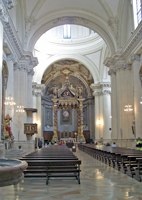
Little survives inside the Duomo to bear witness to its ancient history:
-
✴The church that was built in 1133 had a nave and two aisles, which culminated in a flight of steps up to a semi-circular apse. This apse was built over a crypt formed by the first church on the site. Any remains of this structure lie under the nave of the present church.
-
✴The left transept of the present church corresponds to the extension that was built in 1201, which also had a nave and two aisles.
The church was transformed in the 15th and 16th centuries:
-
✴The apse was rebuilt in 1457-62: a number of payments relating to this work were made to Bartolomeo di Mattiolo da Torgiano, who was the most prominent architect working in Perugia, in 1457-9. Its floor was lowered to the level of that of the nave, at the expense of the crypt below. The traceried windows from this construction are still visible from the exterior of the church (in Via dell’ Oratorio - see the page on the Exterior of the Duomo).
-
✴In 1512, Cola da Caprarola was commissioned to build a new right transept in order to achieve a Latin cross floor plan. A vault collapsed in 1513, and Cola was required to remedy the damage at his own expense. He was documented in relation to this project until 1515.
-
✴Antonio da Sangallo il Giovane is documented in relation to the remodelling of the Duomo in 1517-22. His surviving design in the Uffizi Gallery, Florence depicts a symmetrical Latin-cross floor plan, with a buttressed tribune, a nave of two bays, a cupola over the crossing and a circular crypt below it. The collection also includes preliminary designs for the cupola and for the Cappella del Corpus Domini (see the page on Chapels).
It was probably at this time that the columns in the nave and left transept were removed, the right transept was built and the ceiling was re-vaulted. The cupola was added in 1543-8, perhaps at the behest of the papal legate, Cardinal Tiberio Crispo, to a design by the Florentine Giuliano di Baccio d' Agnolo Baglioni.
The subsequent construction of some 30 chapels and altars by noble families and confraternities ensured that finance was available for the decoration of the church. An important paper by Gabriele Metelli (referenced below) contains archival material relating to this patronage, with particular reference to the patronage of the Roscioli family (below).
Current Interior
The Duomo was badly damaged in the earthquake of 1703. Two architects who were active in Rome were retained to design and supervise the necessary restoration:
-
✴Sebastiano Cipriani restored the apse in 1720-8; and
-
✴Filippo Barigioni submitted a series of designs for the rest of the church in the period 1727-31, but these were never executed.
In 1751, the Cathedral Chapter turned to Luigi Vanvitelli (who was working at that time at San Salvatore). He provided a design in 1754, but he was too busy with other work to execute it. In any case, there was considerable opposition to the plans, not least from the families and confraternities that had chapels and altars in the church.
In 1770, the Commune finally approved a request from the Cathedral Chapter for the remodelling of the church. Vanvitelli visited Foligno in 1771; he was then based in Caserta, near Naples and was en route for Milan, where his associate, Giuseppe Piermarini was looking after their business in that city. Giuseppe Piermarini agreed to supervise the project in his native Foligno from Milan. He visited Foligno in 1772, en route for Caserta, where he consulted Vanvitelli on changes that were needed to the original plan, which had been based on inaccurate drawings by Filippo Barigioni.
Giuseppe Piermarini continued in overall charge of the project after Vanvitelli’s death in 1773.
-
✴The remodelling of the nave was finally completed in 1790, a year after Giuseppe Piermarini returned to live in Foligno.
-
✴Work began on the restoration of the left transept in 1819, eleven years after his death. Advice was received from the Roman architect, Clemente Folchi. The earlier objective of achieving complete symmetry between the two transepts was abandoned so that the existing fabric (and, not least, the minor facade) could be preserved. Instead, a false wall was built near the façade, leaving a trapezoid space between them, so that the floor plan of the rest of the transept was more nearly rectangular.
Tribune and Crossing
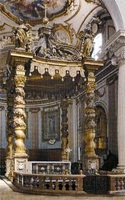
The Cappella delle Reliquie, which had been built in front of the ancient crypt and remodelled in 1587, became increasingly important in the 17th century, when some of the stolen relics of St Felician were returned to Foligno:
-
✴part of the cranium was returned from the Abbey of St Vincent, Metz in 1668; and
-
✴an arm was returned from Minden in 1673.
Dionisio Roscioli received permission in 1697 to build a new high altar, and he made a series of payments for the work in the following two years. He also commissioned the marble double staircase down to the Cappella delle Reliquie and its balustrade in 1700. The chapel was used for the tombs of Dionisio Roscioli in 1702 and his heir, Giuseppe Salvi Roscioli in 1703. The family had now become extinct, and Giuseppe Salvi Roscioli named the Cappella Roscioli (which was actually the area around and including the high altar) as his universal heir. He wished for money raised from his estate to be used for the embellishment of this chapel. (Some of the works of art that were included in the bequest are displayed in the Museo Diocesano). Money raised from this bequest was particularly important after the earthquake of 1703. As noted above, the restoration of the church began in the apse, under Sebastiano Cipriani.
Baldachin (1697)
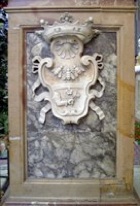
Frescoes (1719-23)
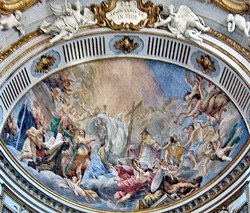
The notary Giustiniano Pagliarini wrote to his friend, Pietro Canneti (a learned monk at Sant’ Apollinaire in Classe) seeking advice on an appropriate artist for the frescoes of the apse. Pietro Canneti suggested Francesco Mancini, who had just completed the frescoes for Canneti’s new library at Sant’ Apollinaire. The choice was not universally popular, but Pagliarini had his way.
There followed a long discussion about the iconography of the frescoes, and the cartoons were not finally delivered until 1722. The frescoes, which were completed in the following year, depict:
-
✴St Felician in glory (in the vault); and
-
✴St Felician entrusting Foligno to Religion (in the lunette of the apse).
In the latter fresco, Religion takes the form of a figure in white holding a cross, while St Michael below spears the devil and St Felician stands to the right. St John the Baptist, on the left, draws the scene to the attention of a group of local saints that includes:
-
✴the Blessed Peter Crisci;
-
✴the Blessed Angela of Foligno; and
-
✴the Blessed Angelina of Montegiove.
There is a small figure of a kneeling donor (presumably Giustiniano Pagliarini) behind them (at the extreme left).
St Felician enthroned (1703-33)
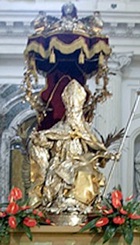
-
✴The throne (1703-13) was made in Rome by the German Adolf Gaap. Some parts of it had to be replaced after a theft in 1982. The relief on the back, which depicts the martyrdom of the saint, are particularly fine.
-
✴The figure of the saint was made in Rome to a design by Giovanni Battista Maini and arrived in Foligno in 1733. The wooden modello is displayed in Palazzo Trinci.
Copy of the Madonna di Foligno (18th century)
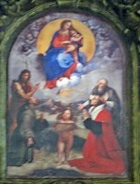
Reliquary of St Peter Crisci
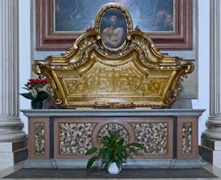
The relics of the Blessed Peter Crisci were originally housed in a reliquary made of crystal and gold in the chapel that now serves as the Baptistery. An inventory that was compiled in 1771 recorded that the relics were removed from the chapel on 26th August of that year. It was presumably at about this time that they were transferred to the present gilded wooden reliquary and moved to the Cappella Jacobilli. The relics were removed for scientific investigation in October 2009 and returned to the reliquary, which is now in the left transept.
Madonna and Child with saints (1834-6)
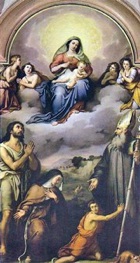
Altarpieces in the Nave
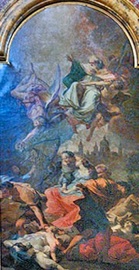
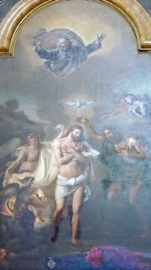
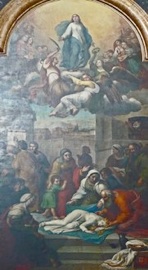
St Felician Liberates Foligno Baptism of Christ Death of St Messalina
from the Plague (1789-91) (1826-35) (1850)
St Felician Liberates Foligno from the Plague (1789-91)
This altarpiece is now on the 2nd altar on the left. Bishop Filippo Trenta originally commissioned it from Gaetano Gandolfi for the high altar when the remodelling of the nave was completed. It was originally signed and dated 1789, but this inscription is no longer legible. It arrived in Foligno in 1791. Unfortunately, it was damaged in the bombing of 1944 and has been largely repainted. (A preparatory study survives in the Palazzo Barberini, Rome).
Baptism of Christ (1826-35)
The Cathedral Chapter commissioned this altarpiece for the 1st altar on the left from Jean Baptiste Wicar. The Berardi arms appear at the bottom of the canvas, probably in commemoration of the prior at that time, Feliciano Berardi. The work was protracted, and the panel remained incomplete in Wicar’s studio in Rome when he died in 1834. His pupil, Decio Trabalza (see below) completed it, and it was received with great enthusiasm in Foligno in 1835. The altarpiece was damaged in the bombing of 1944 and subsequently restored.
There is a preparatory sketch in oil for this work in the Collection of the Fondazione Cassa di Risparmio di Perugia.
Death of St Messalina (1850)
This panel on the 1st altar on the right is by Enrico Bartolomei.
Art from the Duomo
Works in the Museo Diocesano
The following works from the Duomo were mostly removed prior to the remodelling of the nave in 1771, are now in the Museo Diocesano.
St Felician (ca. 1425)
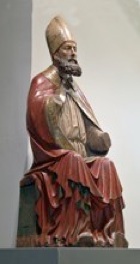
Annunciation (ca. 1599)
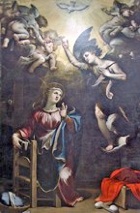
Miracle of St Martin of Tours (ca. 1603)

The altarpiece depicts St Martin reviving from the dead a catechumen (a young man studying in preparation for baptism) so that he could be baptised.
Marriage of the Virgin (1613)
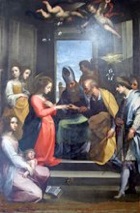
SS Cosmas and Damian (ca. 1636)
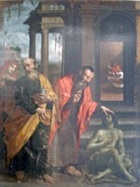
Martyrdom of SS Crispin and Crispinian (ca. 1640)
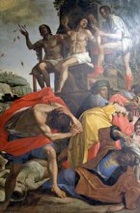
The altarpiece is attributed to Cesare Sermei: preparatory sketches that are almost certainly his work survive in Assisi. It was probably painted between 1635, the year in which the stucco decoration of the altar was executed, and 1642-4, when it was gilded.
Other Works from the Duomo
Stained glass (1485-8)
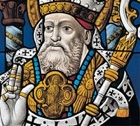
This glass was removed to allow the closure of the windows during the remodelling of the tribune in 1720-8. It was sold to the friars of San Francesco, Assisi in 1782. The figure of St Felician was documented in 1832, when it was installed in the Upper Church. All of the glass that had been reused in San Francesco was removed in ca. 1945, in a restoration that aimed to reproduce the original appearance of the church.
The surviving panes from Foligno, which seem to derive from cartoons by a northern artist, are now in the Museo del Tesoro di San Francesco. They depict:
-
✴from the upper register:
-
•a fragment of St Peter;
-
•the Madonna and Child; and
-
•St Paul; and
-
✴from the lower register:
-
•the upper part of a figure of St John the Baptist (which was heavily restored in the 19th century);
-
•St Jerome;
-
•St Felician (a part of which is illustrated above).
The arms of Brigida degli Elmi (died 1482), whose bequest presumably financed the work, are now exhibited below the madonna and Child, but they were originally below the figure of St Jerome.
Holy Family (1634)
This altarpiece, which is signed by Marcantonio Grecchi and dated by inscription, was removed from an altar in the Duomo in 1728. It is now on the altar on the right of the Chiesa del Suffragio.
Read more:
G. Metelli, “Spigolature d' Archivio: la Quadreria Roscioli; le Cappelle e gli Artisti nella Cattedrale di Foligno”, Bollettino Storico della Città di Foligno, 5 (1981) 123-87
Return to the Main page on the Duomo.
Proceed to the Chapels (Baptistery and Cappella Jacobilli).



